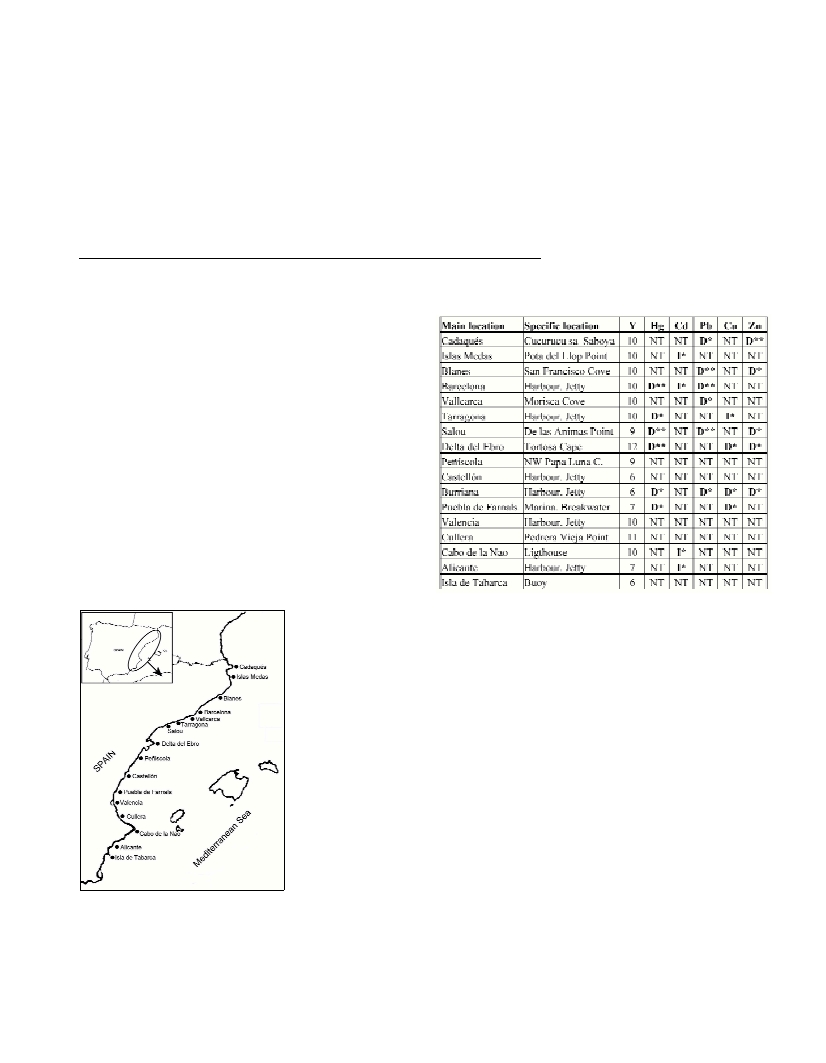TEMPORAL TRENDS OF TRACE METALS IN MUSSEL (MYTILUS GALLOPROVINCIALIS)
FROM THE IBERIAN COAST (NORTHWESTERN MEDITERRANEAN), 1991-2002.
José Benedicto
1*
, Carmen Rodríguez
2
, Concepción Martínez-Gomez
1
, Juan Guerrero
1
Y Antonio Jornet
1
1
Instituto Español de Oceanografía. Centro Oceanográfico de Murcia. San Pedro del Pinatar. Spain - * benedicto@ieo.mu.es
2
Centro Oceanográfico de Santander. Promontorio de San Martín s/n. 39004 Santander. Spain.
Abstract
Trace metal (Hg, Cd, Pb, Cu and Zn) trends at Catalonian and Valencian coast from 1991 through 2002 have been identified by the
Oceanographic Center of Murcia using Mytilus galloprovincialisas bioindicator. The non-parametric Kendal-tau test was used to
determine statistically significant correlations between trace metal concentration and year. The most common observation was that no trend
was evident, but, when trends were noted, decreases greatly outnumbered increases. Lead, mercury, copper and zinc show significant
downward trends in several sites, mainly located on Catalonian coast, while cadmium and copper are the only metals that show an upward
trend.
Keywords: Trace metals, mussel watch, monitoring, temporal trends, coastal waters quality.
Rapp. Comm. int. Mer Médit., 37,2004
172
Introduction
In the last years, the use of marine organisms has become general
to evaluate the environmental quality of coastal waters. Ever since
Goldberg E. (1) proposed the application of the “Mussel Watch”
concept, based on the suitability of mussels as bioindicators of
contamination, most of the national (2,3,4) and international
monitoring programs of marine pollution have adopted it. In Spain,
Mussel Watch is being applied by the Spanish Institute of
Oceanography (I.E.O.). The Mediterranean coast is cover by the
Center of Murcia (5, 6) and the North-Atlantic coast by the Center of
Vigo (7). The main objective of the IEO Mussel Watch Project is to
determine the status and long-term trends of chemical contamination
along the Spanish coast.
Material and methods
In order to minimise natural variability, sampling was made under
standardized conditions, collecting native mussels from the same site
and at the same time of the year (May-June, post-spawning period).
At each site (Fig.1), three subsamples of 50 individuals, size 3 to 4
cm, were collected by hand. Preparation of samples has been
described elsewhere in detail (5). Measurements were performed by
AAS (Perking-Elmer, mod 4.100). Hg was measured by cold vapour
atomic absorption. Intercalibration mussel homogenate samples, from
QUASIMEME, were used as a control for the analytical methods. The
non-parametric Kendal-tau test (8) was used to determine temporal
trends.
Results and discus-
sion
Table I summarizes
the increasing (I), de-
creasing (D) and no
trends (NT) of trace
metal concentrations in
mussels from Cata-
lonian and Valencian
coast obtained for each
metal, considering two
levels of significance
p
=
0.01 (**) and
p
=
0.05 (*), applying
one side test. The most
remarkable results are
the absence of statis-
tically significant tem-
poral trends (60 cases,
70.59 %) and the
predominance of signi-
ficant decrements (20
cases, 23.53 %), as
opposed to the increa-
ses (5 cases, 5.88 %).
Lead and mercury are decreasing at six sites, most of them located on
the Catalonian coast. Zinc is decreasing at five and copper at three.
Cadmium is the only metal that presents a significant upward trend.
This behaviour pattern in metals has been observed in mussels from
the Andalusian coast (6) as well as from the Spanish North-Atlantic
coast (7).
Conclusions
Data from Catalonian and Valencian coast show more decreases
than increases in trace metal concentrations between 1991 and 2002.
At most individual sites there are no strong correlations between
concentration and year, but where correlations are found decreases
outnumber increases. This tendency for contamination to decrease is
occurring at the same time that our society is taking more and more
steps to reduce the emissions of this type of contaminants, as much at
atmospheric level as at level of industrial and urban water purification.
References
1-Goldberg, E., 1986. The Mussel Watch Concept. Environmental
Monitoring and Assessment.,7: 91-103.
2-O’Connors, T.P. and Beliaeff, B., 1995. Recent trends in Coastal
Environmental Quality: Results from the Mussel Watch Project 1986-
1993. National Status and Trends Programme. 40pp.
3-O’Connors, T.P., 1996. Trends in chemical concentrations in mussels
and oysters collected along the U.S. coast from 1986 to 1993. Marine
Environ. Re.s, 41 (2): 183-200.
4-RNO., 2000. Travaux du Réseau National d’Observation de la qualité
du milieu marin. Tendances temporelles des teneurs en contaminants dans
les mollusques du littoral Français. IFREMER, pp. 9-32.
5-Rodríguez, C., Guerrero, J., Benedicto, J. , 1995. Spatial distribution of
heavy metals in the Mediterranean mussel Mytilus galloprovincialisfrom
the Spanish Mediterranean coast. Rapp. Comm. int. Mar. Médit., 34: 145.
6-Benedicto J., Rodríguez, C., Martínez-Gómez, C., 2002.Spatial
distribution and temporal trends of heavy metals levels along the
Andalusian coast using Mytilus galloprovincialisas bioindicator.
Abstracts of the XI
th
Iberian Seminar of Marine Benthos Study, 34.
7-Besada, V., Fumega, J. and Vaamonde, A., 2002. Temporal trends of
Cd, Cu, Hg Pb and Zn in Mytilus galloprovincialisfrom the Spanish
North-Atlantic coast 1991-1999. Sci. Total Environ., 288: 239-253.
8-Hollander M. and Wolf, D., 1999. Non-parametric Statistical Methods.
John Wiley and Sons, Inc.
Table 1. Increasing (I), Decreasing (D), No Trends (NT). Significant at
level 0.01 (**) and 0.05 (*), one side test. Years (Y).
Fig. 1. Map of the study area with the sam-
pling stations.

